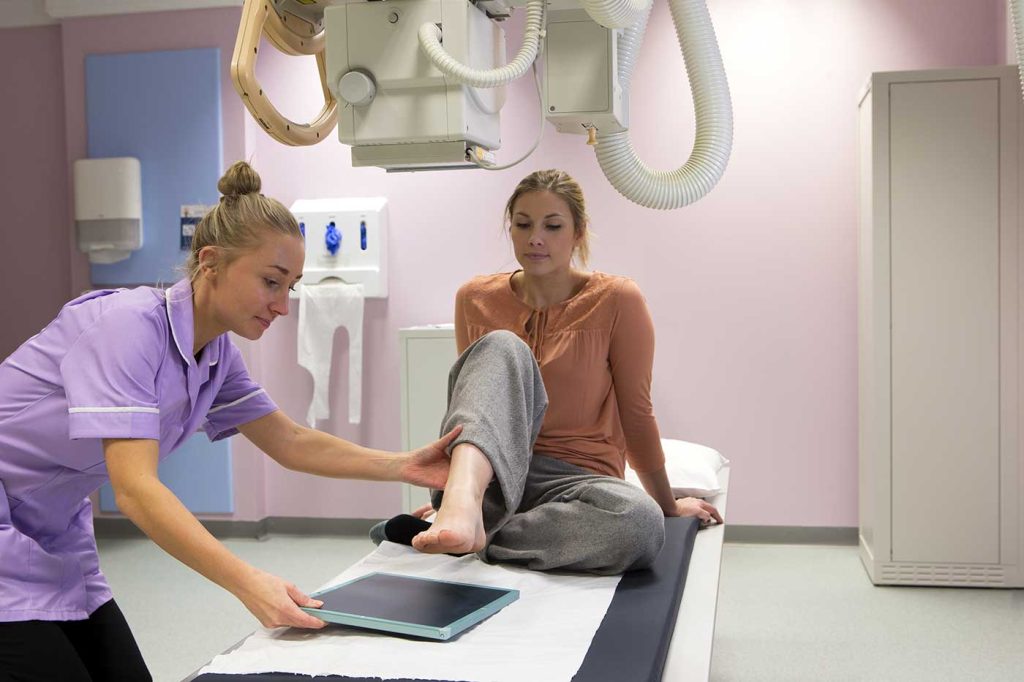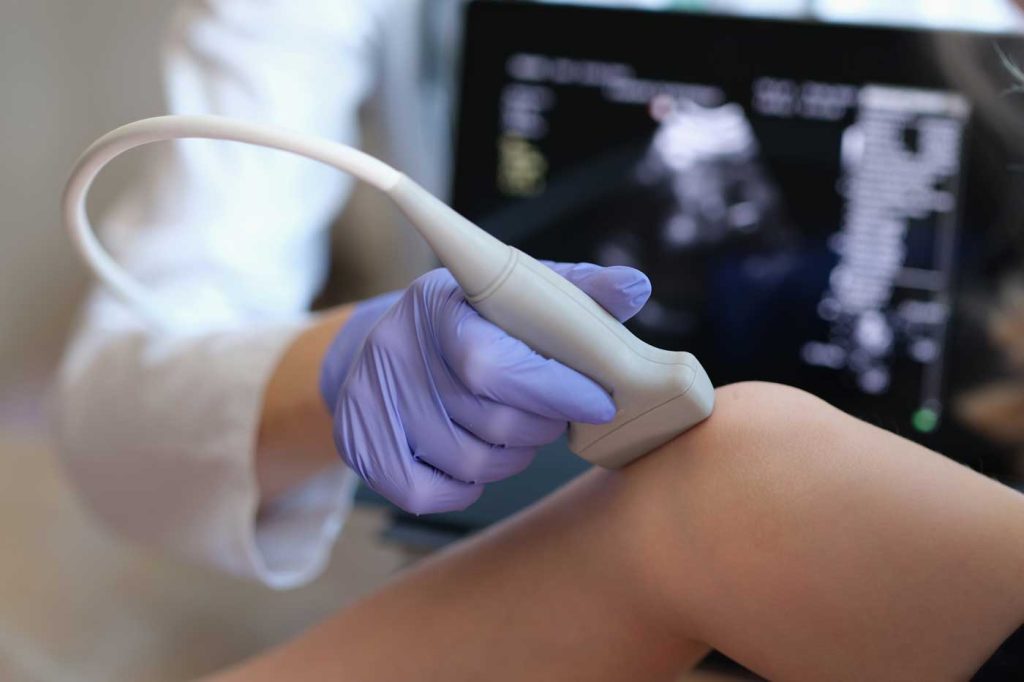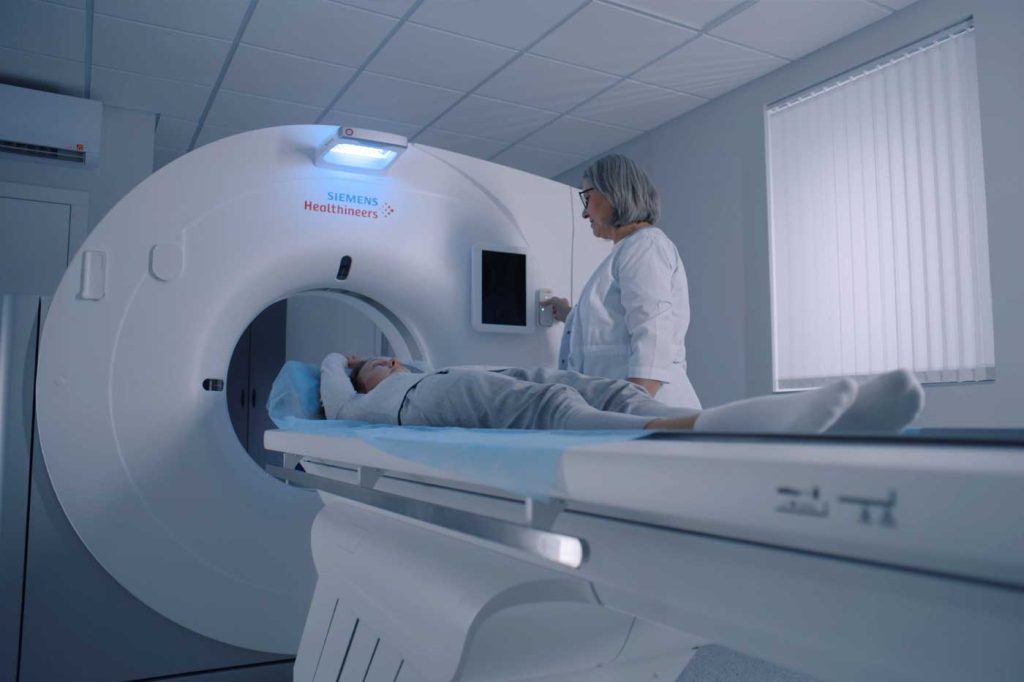Diagnostic Imaging
At OrthoConnecticut, we offer state-of-the art diagnostic imaging with advanced digital radiography.
SCHEDULE AN APPOINTMENTDiagnostic Imaging Serving Danbury, Litchfield, Fairfield Areas in CT
A sound and accurate diagnosis is a crucial element of the expertise we offer our patients, and we continually strive to maintain the most comprehensive and highest quality offerings in digital imaging.

In-Office Imaging
Each of our offices house high quality digital Xray technology and our highly trained radiologic technologists work closely with our orthopedic surgeons and PAs to obtain the best and most accurate imaging to help provide a clear diagnosis and treatment plan. For more complex issues that require more advanced imaging or MRI, we will prescribe imaging at one of the fully equipped radiology practices in the region. Your physician will discuss the results with you soon after your office visit, providing you with the comfort of having an understanding about your condition or injury promptly.
Digital Xray
Digital Xray is superior to traditional film Xray. With digital technology, a patient’s Xray experience is faster and less stressful. The use of digital Xray eliminates the need for film processing and allows the image to be viewed on a computer screen in the patient exam room. The images produced with digital technology are clearer resulting in a more accurate diagnosis.
Diagnostic Musculoskeletal Ultrasound
Diagnostic musculoskeletal ultrasound is used to diagnose and treat patient injuries and conditions. Sound waves are used to produce images of a patient’s internal body tissues (muscles, tendons, ligaments, joints and soft tissue throughout the body). Ultrasound gel is applied directly to the patient’s skin and a small ultrasound head (transducer) is moved over the area of concern. The ultrasound head collects the “sounds” and the “sounds” are transmitted back to a computer where an image(s) is produced. Ultrasound imaging is safe and painless.

Magnetic Resonance Imaging (MRI)
What is an MRI?
This scan lets doctors see inside your body without using radiation. Instead, MRIs use magnets and radio waves. An MRI shows clear views of your soft tissues. It can show cancer and other problems.

MRI Preparation
Before you have an MRI, you have to remove your glasses, jewelry, hearing aids, dentures and other items. People who have certain types of medical implants can’t have an MRI. You’ll be asked about your medical history to make sure it’s safe for you. You may be given a gown and hearing protection to wear. Medicine may be used to relax you. You may be given a special dye to drink, or given it through an IV needle or other method. The dye helps the scanner see things in your body more clearly.
The MRI Scan
To begin your scan, you lie on a table that slides into the MRI machine. The machine is a big tube that’s open on both ends. When it starts, you hear loud banging and humming noises. Those sounds are made by the magnet. There aren’t any moving parts around your body. You must stay perfectly still so the machine can get a clear view. A scan usually takes 15 minutes to an hour. If you move during the scan, the images will be blurry and it may need to be redone. A technician in a room next to you will watch you and the images being taken. The technician will talk to you through a speaker to let you know what is happening during your scan.
Review of Your MRI
When your MRI is done, you can go home. Doctors will review the images and will talk to you about them at a followup appointment.
Frequently Asked Questions About Diagnostic Imaging:
What is the Difference Between Diagnostic Imaging and Radiology?
The terms diagnostic imaging and radiology are often used interchangeably by the public when referencing imaging exams, but they really are two different concepts, both of which are used to make diagnoses. Radiology is a medical specialty in which a radiologist, a doctor who has deeply studied the field, uses radiant energy to diagnose and treat diseases. Diagnostic imaging is the technology that radiologists use to read and interpret images, and it includes X-ray, MRI, CT scan, and Ultrasound. At OrthoConnecticut, we perform on-site digital X-ray and diagnostic musculoskeletal ultrasound to help confirm orthopedic diagnoses.
Is Diagnostic Imaging the Same as MRI?
An MRI (magnetic resonance imaging) is one type of diagnostic imaging tool. It is used to detect tumors, injuries, lesions, and infections. MRIs do not use any radiation. Instead, they involve a powerful magnet and radiofrequency waves that create 3-dimensional images of organs, muscles, and tissues inside your body. When our patients require MRI, we refer them to our radiology colleagues who use state-of-the-art MRI equipment to perform the latest MRI techniques available today.
Is an Ultrasound Considered Diagnostic Imaging?
Ultrasound is another form of medical diagnostic imaging that produces live, real-time digital pictures. It uses a small probe to transmit sound waves into the body and records the sound waves that echo back to the equipment. This process produces images that display on the technologist’s computer screen. Ultrasound does not use any radiation, which is why it is often used to observe pregnant women whose babies are in utero. In orthopedics, ultrasound can provide detailed views of a person’s muscles and tendons, and help determine if a condition is muscle, tendon or bone-related.
What are the most common tests used in orthopedic evaluations?
There are a variety of assessments that can be used to diagnose and screen for orthopedic conditions. Testing confirms the location and severity of the issue and determines if other causes for pain or mobility issues may be at play.
Common orthopedic tests include bone densitometry, skeletal scintigraphy, discography, myelography, and electromyography. Most of these exams use X-ray, MRI, ultrasound, or computed tomography to confirm a diagnosis. Other tests, such as flexibility tests, stress or muscle tests, and gait analysis, may be used to assess the range of motion or identify skeletal alignment abnormalities or muscle function issues. The field of orthopedics also utilizes other exams, including muscle and bone marrow biopsy, to help identify conditions and crystallize diagnoses.
How Should I Prepare for an Imaging Appointment?
Most X-ray or diagnostic ultrasound imaging procedures at OrthoConnecticut do not require prior preparation.
However, if you are going to your radiologist’s office for an imaging appointment, some common steps in preparing for it may include:
- Not eating or drinking 3-12 hours before your appointment
- Informing your physician of any medical conditions
- Reporting any metal or foreign objects in your body (such as pacemakers, metal prosthetics, etc.)
- Removing all metal jewelry or watches
It’s important to consult with your physician or radiologist’s office, as these instructions may differ based on the type of exam.
What Kind of Conditions Can be Treated at OrthoConnecticut?
OrthoConnecticut is equipped to offer patients state-of-the-art advanced digital radiography services for hands, feet, hips, joints, shoulders, elbows, spine, and more. We perform digital X-ray and digital diagnostic ultrasound in our offices.
What Does Diagnostic Imaging Include?
Diagnostic imaging is when a doctor looks “inside” your body, through advanced imaging technology, to discover clues about a possible medical condition. A diagnostic imaging appointment will include different machines and techniques depending on the type of imaging you receive. Types of diagnostic imaging include:
- CT Scans
- MRI Scans
- Ultrasound
- X-Rays
- Mammography
- Nuclear Medicine
Most medical imaging tests are easy and pain-free, though they may be uncomfortable if you have to stay inside a machine for an extended period of time. For example, a CT scan can last anywhere from 15 minutes up to an hour. Some tests may incorporate exposure to small amounts of radiation.
Other imaging tests use a scope, a long tube with a tiny camera on its end, to do diagnostic imaging. Using a scope for imaging typically requires anesthesia. A doctor will carefully move the scope through your body to see inside certain organs or joints.
What is Diagnostic Imaging Used for?
Diagnostic imaging is used to diagnose, monitor, and treat certain diseases by creating images that provide a picture of the interior of your body. It allows physicians to make earlier diagnoses which often leads to better patient outcomes. Medical imaging has also revolutionized the healthcare industry and reduced the need for unnecessary invasive procedures. Diagnostic imaging is used for:
- Diagnosing the root cause of medical problems
- Monitoring your body’s response to treatments, such as chemotherapy for cancer
- Regular screening for illnesses like breast or colon cancer
Call OrthoConnecticut today at 1.833.678.4628 to learn more or to schedule an appointment.



